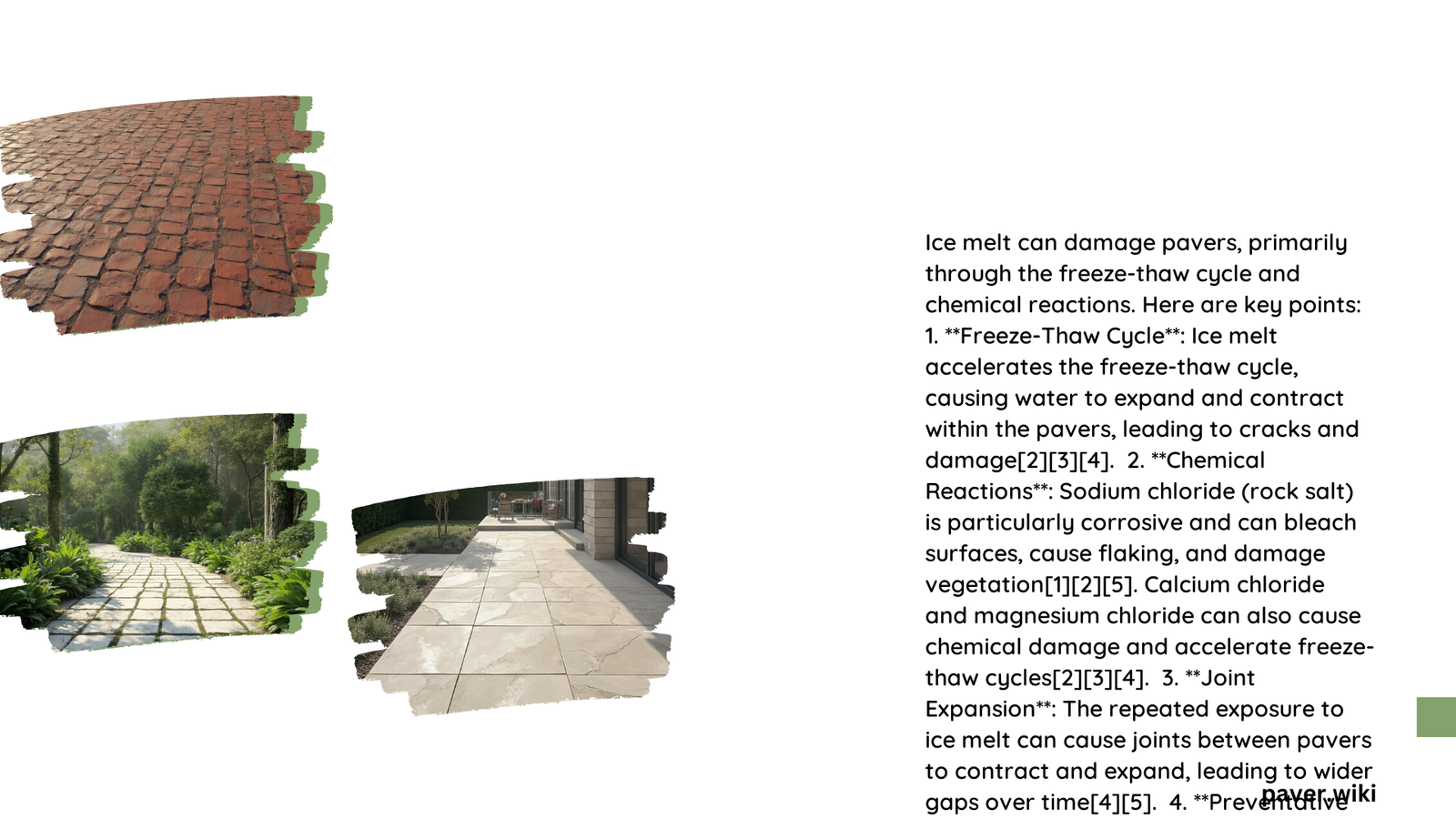Ice melt products can indeed damage pavers, particularly concrete, brick, and natural stone varieties. The severity of damage depends on the type of ice melt used and the paver material. Sodium chloride (rock salt) is especially harmful, causing cracking, spalling, and discoloration. Calcium chloride and magnesium chloride are also damaging. Safer alternatives exist, but proper application and preventive measures are crucial to minimize paver damage during winter months.
What Are the Effects of Ice Melt on Different Paver Materials?
Concrete Pavers
Concrete pavers are particularly vulnerable to ice melt damage:
- Sodium Chloride (Rock Salt):
- Effective to 15°F
- Causes significant damage
- Accelerates freeze-thaw cycles
- Leads to cracking and spalling
- Reacts with calcium silicate hydrates in cement
-
Causes expansion and contraction, widening joints
-
Calcium Chloride:
- Effective to -20°F
- Highly corrosive
- Causes chemical damage to concrete
- Toxic if ingested
-
Damages vegetation
-
Potassium Chloride:
- Effective to -15°F
- Less damaging than sodium chloride
- Can pollute waterways
-
Skin irritant
-
Magnesium Chloride:
- Effective to -8°F
- Not recommended for concrete pavers
- Causes chemical damage
- Accelerates freeze-thaw cycles
Brick Pavers
Brick pavers face unique challenges with ice melt:
- Sodium Chloride (Rock Salt):
- Attracts moisture due to hygroscopic nature
- Moisture expands upon freezing, causing cracks or splits
- Leads to joint contraction and expansion
-
Results in wider gaps over time
-
Calcium Magnesium Acetate (CMA):
- Safer option for brick pavers
- Less corrosive
- Doesn’t damage brick or surrounding vegetation
- May be less effective in extremely low temperatures
Natural Stone Pavers
While specific data is limited, general principles apply:
- De-icing Salts:
- Can damage natural stone
- Accelerate freeze-thaw cycles
- Cause chemical reactions leading to deterioration
- Applying a protective sealer can significantly reduce damage
How Does Ice Melt Residue Impact Pavers Long-term?

- Surface Degradation:
- Repeated exposure leads to chafing and crumbling
-
Pressure from freeze-thaw cycles accelerates aging
-
Discoloration:
- Ice melt products, especially sodium chloride, cause discoloration
-
Can lead to flaking of paver surfaces
-
Structural Integrity:
- Freeze-thaw cycles cause cracking and spalling
- Reduces structural integrity over time
What Are Effective Cleaning Techniques for Ice Melt Residue?
- Removing Residue:
- Wash away salt residue in spring or when temperatures allow
-
Prevents buildup that can continue damaging pavers
-
Protective Measures:
- Applying a protective sealer reduces water infiltration
- Prevents harmful substances from penetrating pores
- Can extend paver life expectancy by 3 to 5 times
What Preventive Measures Can Minimize Ice Melt Damage?
Recommended Application Techniques
- Use in moderation
- Mix ice melt with sand for traction
- Apply before storms and add layers as needed
- Remove snow and ice before applying ice melt
- Avoid using on new concrete (less than one year old)
Alternative Materials or Methods
- Sand or Gravel:
- Effective traction aids
-
No damage to pavers or landscape
-
Pet and Eco-Friendly Products:
- 100% salt-free and chloride-free options available
- Safe for pets, children, and environment
- Effective in melting ice without damaging pavers
How Do Ice Melt Products Compare in Cost and Effectiveness?
| Product Type | Cost | Effectiveness | Damage Potential |
|---|---|---|---|
| Traditional Ice Melts (Sodium Chloride, Calcium Chloride) | Low | High | High |
| Eco-Friendly Products (Safe Paw, CMA-based) | High | Moderate to High | Low |
What Do Case Studies Reveal About Ice Melt Damage?
- Incidence of Damage:
- Frequent application leads to increased repair costs
-
Reduces paver lifespan significantly
-
Environmental Factors:
- Extreme temperature fluctuations exacerbate damage
- High moisture levels increase vulnerability
- Areas with frequent freeze-thaw cycles are most at risk
How Does Ice Melt Affect Repair Costs and Paver Lifespan?
- Repair Costs:
- Substantial increase in long-term maintenance expenses
-
Sealed installations last 3 to 5 times longer than untreated surfaces
-
Lifespan Reduction:
- Unsealed concrete pavers exposed to de-icing salts:
- Normal lifespan: 20-30 years
- Reduced lifespan: 5-10 years
- Factors influencing reduction:
- Frequency of exposure
- Environmental conditions
In conclusion, while ice melt products are effective for winter safety, they can significantly damage pavers. Using alternative methods, applying sealants, and proper maintenance can help mitigate these effects and preserve the longevity of your paved surfaces.
References:
1. https://breakinggroundomaha.com/winter-paver-care-ice-melt-affect-pavers/
2. https://sunburstdeck.com/is-ice-melt-safe-for-my-patio-pavers/
3. https://safepaw.com/safest-ice-melt-for-brick-pavers/
